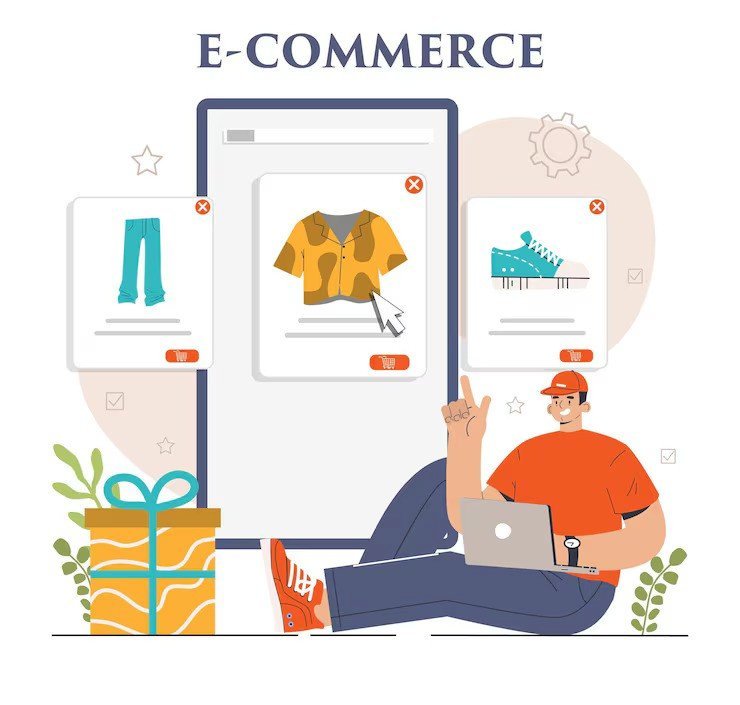Top eCommerce Trends Shaping the Future of Online Shopping in 2025
Explore the latest eCommerce trends redefining online shopping in 2025. From AI to mobile commerce, stay ahead with insights on what’s driving digital retail success.

The world of online shopping is changing fast. In 2025, more people are shopping online than ever before. They want quick service, simple websites, and personal attention. If you have a Shopify store, you need to follow the latest trends to stay ahead and grow your business.
This article will explain the most important eCommerce trends in 2025. It also shows how Shopify store owners can use these ideas to get more customers and more sales.
1. More People Shop on Mobile Phones

Image source: pinterest.com
Most online shoppers now use their mobile phones. In 2025, more than 75 out of 100 people shop online using their phones. That number is still growing as people use smartphones for everything—from checking prices to placing orders.
Your Shopify store must work very well on phones. Use a mobile-friendly theme, large buttons, simple menus, and make sure everything loads quickly. A slow website on mobile can cause people to leave before buying.
Google also gives better rankings to mobile-optimized sites, so making your store mobile-friendly helps with SEO too.
2. Shopping by Voice is Growing

Image source: pinterest.com
More people now use voice assistants like Alexa, Siri, and Google Assistant to shop. They simply speak a command like “Order black running shoes,” and get results. Voice shopping is expected to bring over $40 billion in global sales in 2025.
To prepare your Shopify store, use short and clear product names. Write in natural, simple language. Add an FAQ section with common voice-like questions such as “Where is my order?” or “What size should I choose?”
Voice search is growing fast, and optimizing for it helps you reach more people in new ways.
3. AI (Artificial Intelligence) Makes Shopping Smarter

Image source: glance-cdn.com
AI helps Shopify stores show the right products to the right people. It can suggest items a customer might like, answer questions through chatbots, and even help manage your inventory. If you want to use AI tools well or build smart features in your store, it can be very helpful to hire Shopify developers. They can set up custom tools, improve your site’s performance, and make sure everything works smoothly.
Many Shopify apps use AI to send smart emails, recommend products, and give better customer service. AI also helps predict which products may sell out soon or need to be restocked. Using AI saves time, reduces errors, and helps boost your sales.
4. People Buy Through Social Media

Image source: pinterest.com
Social media platforms like Instagram, TikTok, and Facebook are now places where people shop every day. In 2025, short videos and product posts help shoppers discover and buy things instantly.
With Shopify, you can connect your store to social media apps and tag your products directly in posts and stories. This allows people to buy while scrolling, without leaving the app.
Shopify also tracks sales and performance from these channels, helping you see what content works best. Social media is now one of the most powerful sales tools available.
Read Also: Top Social Media Growth Strategies in 2025: What Works vs. Hype
5. Shoppers Want Eco-Friendly Products

Image source: pinterest.com
In 2025, shoppers care more about the environment. About 70% of customers say they are more likely to buy from a brand that supports eco-friendly practices.
People want products with less plastic, greener packaging, and responsible sourcing. Shopify stores that highlight their sustainability efforts build more trust and loyalty.
You can add a section on your site about your green practices, use recyclable packaging, and work with eco-conscious suppliers. Apps like EcoCart can help offset your shipping carbon footprint.
6. AR (Augmented Reality) Helps Customers See Products Better

Image source: pinterest.com
Augmented Reality (AR) lets customers see what products look like in real life. For example, they can view how a couch fits in their living room or how glasses look on their face.
Shopify supports 3D product previews and AR tools that can be added to product pages. This gives customers a better idea of what they are buying, reduces returns, and improves confidence.
If your store sells furniture, home decor, fashion, or beauty products, AR can give you a big advantage.
7. Subscriptions Are Still Popular

Image source: pinterest.com
In 2025, many people love getting monthly deliveries of products they use often. These include coffee, skincare items, snacks, vitamins, and pet food.
Shopify supports subscription-based selling through apps like Recharge and Bold Subscriptions. These let customers pick how often they receive items and give them the option to pause or cancel easily.
For businesses, subscriptions bring predictable income and increase customer loyalty. Offering a “subscribe and save” option on products is a smart move this year.
8. Customers Expect Fast Delivery

Image source: pinterest.com
Today’s customers don’t want to wait. Many expect their orders to arrive in 1 to 3 days. If delivery is slow, shoppers may leave your store and go elsewhere.
Shopify offers tools and integrations to help with fast delivery. You can use the Shopify Fulfillment Network or third-party services like ShipBob, which allow you to store products in warehouses close to customers.
Show delivery time clearly on product pages and send tracking updates after checkout. This helps build trust and keeps your customers happy.
9. Personalised Shopping with Customer Data

Image source: pinterest.com
Personalization means giving each customer a unique shopping experience. People like it when your store remembers their name, shows their favorite products, or sends them useful suggestions.
You can collect customer data through sign-ups, purchase history, and preferences. Then use this data to send personal emails, recommend items, and offer special discounts.
Apps like Klaviyo, Omnisend, and Privy help make this process simple. Personalized shopping increases customer satisfaction and makes them more likely to return.
10. Selling to Other Countries is Easier

Image source: pinterest.com
In 2025, more Shopify stores are expanding to global markets. Selling to international customers is now simple with Shopify Markets.
This tool helps you show prices in different currencies, translate your site into local languages, and handle taxes and shipping rules for each country.
Expanding globally helps you reach new buyers and grow faster. Shopify Markets does the hard work for you, so you can focus on selling.
11. You Can Work with Shopify Experts to Improve Your Store

Image source: pinterest.com
As your store grows, you may want to improve its design, speed, or features. Sometimes, you’ll need help from a professional developer.
A Shopify expert can create a custom layout, add unique tools, fix bugs, and improve how fast your site works. This helps give your customers a better shopping experience and increases conversions.
You can find certified Shopify developers through the Shopify Experts Marketplace or trusted agencies.
Conclusion
Running a Shopify store in 2025 is exciting and full of opportunities. But you need to follow the latest trends to stay successful. Shoppers expect fast service, mobile-friendly sites, smart features, and eco-friendly products.
Using tools like AI, AR, personalized emails, fast shipping services, and social selling can help you grow. Even small improvements make a big difference over time.
Try new things, listen to your customers, and always work to make your store better. That’s how you’ll succeed in 2025 and beyond.
FAQs
1. What is the biggest eCommerce trend in 2025?
Most people shop using their phones. Having a mobile-friendly website is the most important trend right now.
2. Should I care about voice shopping?
Yes. Many people use voice assistants like Alexa or Siri to find and buy products. You should make your site easy to use for voice search too.
3. How does AI help my Shopify store?
AI helps you show the best products to the right people, send smart emails, and give quick answers using chatbots.
4. Are subscriptions still useful in 2025?
Yes. People love getting products every month. It’s easy and saves time. Subscriptions also give you regular income.
5. Why should I hire a Shopify developer?
A developer can build special features, fix problems, and make your store work faster. It helps you grow your store better.

















